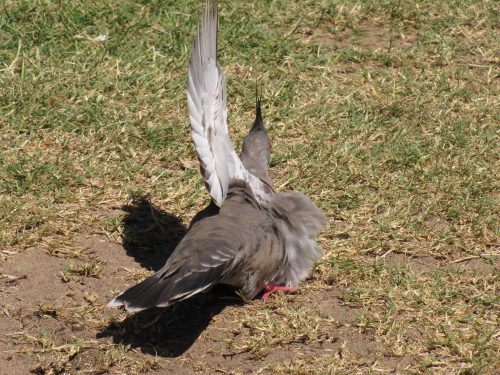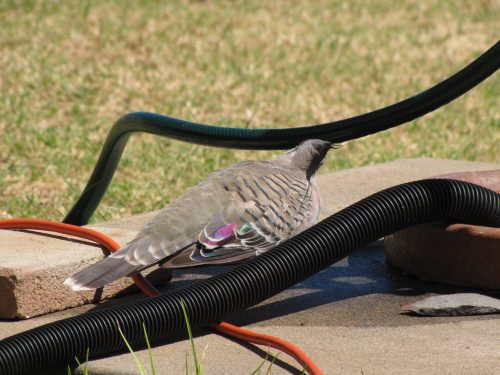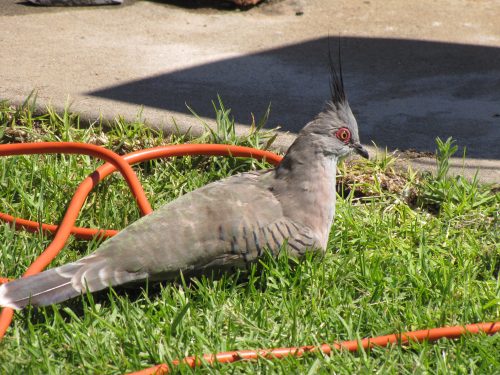Crested Pigeons like to sun themselves
In my last post, I wrote about a recent visit to the Brighton Caravan Park in the southern parts of Adelaide in South Australia. We were staying with several other couples who had also brought their caravans. This lovely park is adjacent one of Adelaide’s best beaches – and there are many wonderful beaches along this stretch of coastline. Our caravan was situated with a good view of the ocean, and only a few steps to the beach.
Over a four day stay at the park, we had many opportunities to just sit a chat with our friends, or gaze out to sea. On the Sunday, we were sitting in the shade of our friend’s caravan having lunch. The park was relatively quiet at that time and a small flock of Crested Pigeons came near to us. They were initially interested in the dripping tap near our van. This tap was attached to the water supply leading to our van. It was quite a warm day and the birds appreciated a little extra water (see photo below).
One of the pigeons decided that it was time to sit in the sun and take advantage of the warm sunlight (see photo at the top of this post). I have seen many birds sunning themselves in this fashion. I wrote a detailed article about this habit here. In this other article, there is a link to a more detailed article on why birds indulge in sunbathing or sunning themselves. In short, it appears that they are trying to rid their plumage of lice.
I guess it also feels nice.
Good birding,
Trevor
Further reading:
Australian Magpie sunning itself
I’ve had this set of photos waiting for several months until I found the time to post them. I finally got around to it.
I observed the male Australian Magpie shown in the photos in our garden one sunny day. I can’t remember how hot it was, but I was intrigued by the bird’s behaviour. It was quite unconcerned by my presence a few metres away, but this is not unusual. Our resident magpies are quite used to us moving about the garden, and although they are still a little wary, they will come quite close.
This one stayed almost in the one spot over about five minutes while I took the series of photos shown here. It did some preening of its feathers, but it also appeared to be sunning itself. Sunning behaviour is quite common in many Australian species. I have most commonly seen it in various species of pigeons and doves. Sometimes I’ve also seen it in association with sand bathing; House Sparrows often do this.
One of my reference books records instances where the wings of magpies can stretch above the head until touching during sunbathing behaviour. The bird I observed only briefly opened the wings.
These photos were taken mid morning. Many species will use sunning behaviour first thing on cold mornings. I guess we all need a good stretch and warming up on a cold morning.
Update Feb 29th, 2016: It is thought that birds probably sunbathe to rid their plumage of lice. Read the article Sunny Side Up for a long discussion on this.
I have seen this sunbathing behaviour in the following species: Crested Pigeon, Spotted Turtledove, House Sparrows, Red Wattlebirds, and Noisy Miners.
I have since written another article about this behaviour called Topsy the Crested Pigeon.
For a much longer explanation of why birds sunbathe read this article: Sunny Side Up on the Australian Birdlife site.












